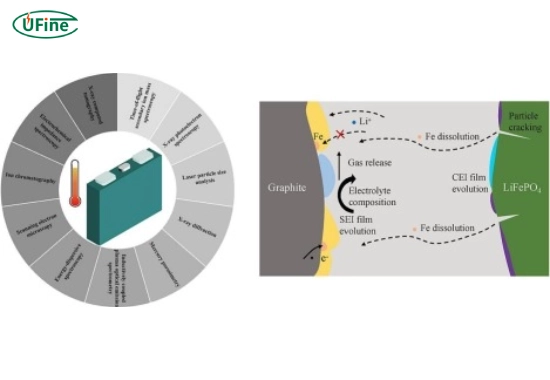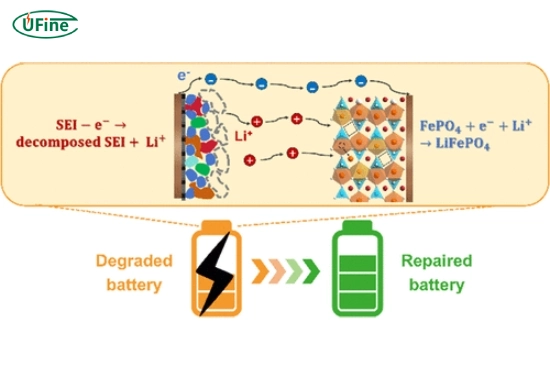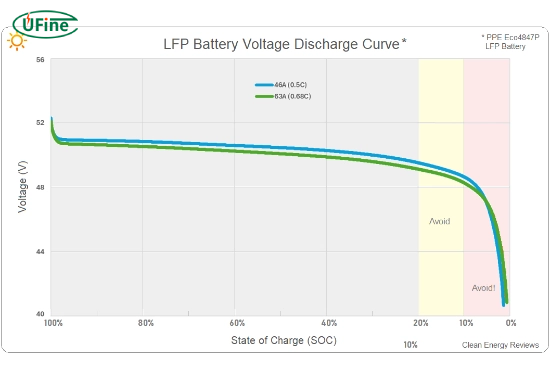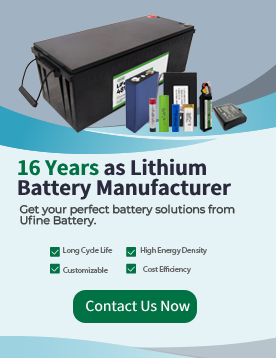Can battery degradation be reversed on LFP batteries? This question is critical for industries and consumers relying on Lithium Iron Phosphate (LFP) batteries for electric vehicles (EVs), renewable energy storage, and portable electronics. While LFP batteries are praised for their safety, long cycle life, and thermal stability, they inevitably lose capacity over time. This comprehensive guide will dissect the science of degradation, separate fact from fiction about reversing it, and provide actionable strategies to maximize battery lifespan.
Part 1. What causes irreversible degradation in LFP batteries?
LFP battery degradation results from permanent chemical and structural changes within the cells. Key factors include:
1.1 Cycle aging
Every charge-discharge cycle causes mechanical stress. Lithium ions move between the cathode (LFP) and anode (graphite), creating microscopic cracks in the graphite anode. Over thousands of cycles, these cracks reduce the anode’s ability to store ions.
1.2 Calendar ageing
Even unused batteries degrade. Electrolyte components slowly break down, forming resistive layers on electrode surfaces. At 25°C, an LFP battery loses ~2-3% capacity annually; at 40°C, losses jump to ~8-10%.
1.3 Voltage extremes
- Overcharging (above 3.65V per cell): Causes lithium plating on the anode, blocking ion pathways.
- Deep discharging (below 2.5V per cell): This leads to copper dissolution in the anode, permanently damaging conductivity.
1.4 Temperature abuse
- High heat (>35°C): Accelerates electrolyte decomposition and SEI (Solid Electrolyte Interphase) growth.
- Extreme cold (<0°C): Slows ion movement, forcing the battery to work harder and generate internal heat.
Once these changes occur, they cannot be undone—like trying to un-bake a cake.
Part 2. The chemistry of LFP degradation: Why reversal is nearly impossible
2.1 Anode degradation
Due to repeated lithium insertion/extraction, the graphite anode develops cracks and pulverization, reducing its surface area and limiting ion storage.
2.2 Cathode stability
While LFP cathodes degrade slower than other lithium-ion chemistries, iron dissolution can occur in high-voltage conditions, weakening the cathode’s structure.
2.3 SEI layer growth
A thin SEI layer forms naturally on the anode to protect it. Over time, this layer thickens due to side reactions, permanently trapping lithium ions and increasing internal resistance.
2.4 Electrolyte breakdown
The liquid electrolyte (usually LiPF₆ in organic solvents) decomposes into gases like CO₂ and HF, reducing ion conductivity. This is irreversible without replacing the electrolyte—a process impossible in sealed cells.
Part 3. What can you do to improve degraded LFP batteries?
While complete reversal is off the table, these methods can recover 5-15% of lost capacity:
3.1 Cell balancing
Problem: Imbalanced cells force the BMS to limit capacity to the weakest cell.
Solution: Use a balance charger to equalize voltages across cells.
Example: After balancing, a 48V LFP pack with one cell at 3.2V and others at 3.3V can regain ~7% capacity.
3.2 BMS recalibration
Problem: Aging batteries give inaccurate State of Charge (SOC) readings.
Solution: To recalibrate the BMS, perform a complete discharge-charge cycle (0% to 100%) every six months.
3.3 Temperature management
Problem: Heat accelerates degradation.
Solution: Install active cooling (e.g., fans or liquid systems) to maintain 20–25°C. A study by Battery University showed LFP cells at 25°C retained 92% capacity after 2,000 cycles vs. 78% at 40°C.
Part 4. Debunking 5 dangerous myths about reversing LFP degradation
Myth 1: “Deep cycling fixes degradation.”
Reality: Fully discharging LFP batteries stresses cells and worsens anode damage.
Myth 2: “Adding conductive additives restores capacity.”
Reality: While carbon additives improve new batteries, they can’t repair cracked electrodes in degraded ones.
Myth 3: “Storing batteries in the freezer stops aging.”
Reality: Freezing temperatures (-20°C) cause electrolyte crystallization, permanently reducing performance.
Myth 4: “Pulsed charging reverses SEI growth.”
Reality: Pulsed charging reduces heat but doesn’t dissolve the SEI layer.
Myth 5: “Software updates can magically restore lithium ions.”
Reality: Software optimizes BMS algorithms but can’t undo physical/chemical damage.
Part 5. How to slow degradation: Best practices for LFP battery users?
5.1 Charging habits
- Ideal range: Keep SOC between 30% and 90% for daily use.
- Avoid fast charging: Charge at ≤0.5C (e.g., 25A for a 50Ah battery).
- Stop at 3.45V/cell: Charging to 3.65V/cell gives 100% SOC but accelerates SEI growth.
5.2 Storage guidelines
- Long-term storage: Store at 50% SOC and 15–25°C.
- Recharge every 6 months: Prevent self-discharge from dropping voltage below 2.5V/cell.
5.3 Environmental controls
- EV owners: Park in the shade or garages to avoid direct sunlight heating batteries.
- Solar storage: Install batteries in climate-controlled enclosures.
Part 6. Case study: Real-world examples of LFP degradation management
Case 1: Tesla Powerwall 2 (LFP version)
Issue: A user reported 18% capacity loss after 5 years.
Solution: Avoided discharges below 20%, installed cooling fans, and balanced cells.
Result: Regained 6% capacity and slowed further degradation.
Case 2: BYD electric bus fleet
Issue: Buses lost 25% range in 3 years due to frequent fast charging.
Solution: Switched to slow overnight charging and added thermal management.
Result: Degradation rate dropped from 8% to 3% per year.
Part 7. When to replace vs. repair: Cost-benefit analysis
7.1 Replacement indicators
- Capacity below 70%: A 100Ah battery delivering <70Ah under load.
- Voltage sag: Voltage drops >15% under moderate load.
- Physical damage: Swelling, leaks, or rust on terminals.
7.2 Repair options
- Cell replacement: Replace individual faulty cells (costs ~30% of a new battery).
- BMS upgrade: Modern BMS units improve balancing (costs $50–$200).
Example: Replacing 4 degraded cells in a 48V LFP pack costs ~$400 vs. $1,500 for a new pack.
Part 8. How to test your LFP battery’s health at home
8.1 Capacity test
- Fully charge the battery.
- Discharge at 0.2C (e.g., 10A for a 50Ah battery) until voltage reaches 2.5V/cell.
- Measure total energy (Ah) delivered.
Degradation = (Original Capacity – Measured Capacity) / Original Capacity × 100
8.2 Internal resistance test
Tool: Use a milliohm meter.
Healthy cell: <1 mΩ.
Degraded cell: >2 mΩ.
Artikel Terkait: Can Battery Degradation Be Reversed?
Part 9. FAQs
Can you use a desulfator on LFP batteries?
No. Desulfators are for lead-acid batteries. They do not affect LFP degradation.
Do LFP batteries degrade if never used?
Yes. Calendar ageing causes ~2-3% annual capacity loss, even in storage.
Can you mix old and new LFP cells?
Not recommended. Old cells drag down new ones, accelerating degradation.
Does partial charging extend lifespan?
Yes. Charging to 80% instead of 100% reduces SEI growth by ~40%.
Are LFP batteries worth the higher upfront cost?
Yes. Their 2–3x longer lifespan vs. NMC batteries offsets initial costs.
Related Tags:
More Articles

Is Battery Acid Dangerous? How to Prevent & Clean It
Learn what battery acid is, why it forms, its dangers, and how to handle spills safely. Discover ways to reduce battery acid leakage and dispose of batteries.
How to Choose a Long-Life Smartwatch Battery?
Want to improve your smartwatch battery life? Learn about different battery types, lifespan, factors affecting longevity, and tips for making your smartwatch battery last longer.
18500 Battery Fundamentals: Specifications, Performance, and Applications
The 18500 battery is a compact, rechargeable lithium-ion cell. Explore its specs, performance, applications, advantages, and safety tips.
How to Choose a Pick Trailer Battery?
Confused about trailer batteries? We'll guide you through voltage, capacity, & types. Find the perfect power source for worry-free adventures. Read more now!
14250 Battery Guide: Specifications, Applications, and What Sets It Apart
The 14250 battery offers high energy density and reliability. Explore its specs, types, advantages, applications, and safety best practices.






